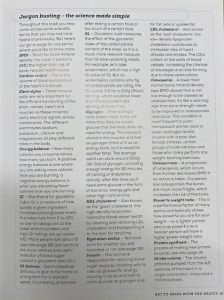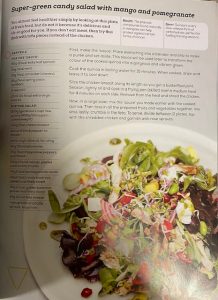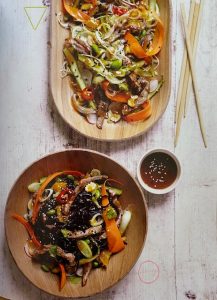Overview
Fitness Food: Delicious recipes for peak performance at any level as a whole is a nutrition based cookbook, written to educate and promote nutrition. It has pages explaining the effects of the different macronutrients, alcohol, and water, as well as how the body makes muscle, uses carbs, and makes energy. It also includes a dictionary explaining all the scientific jargon..

The book is tailored towards performance at any level, but specifically those wanting to burn, balance, or build (Coates, 2017, p. 8-12).

It was written by Christian Coates, along with the help of leading nutritionists and top chefs. In addition to this book, Coates has also written Fitness Gourmet and founded Soulmatefood, which is a service that sends gourmet, adaptable meals to subscribing homes, with the objective of bringing healthy cooking to anyone wanting to improve their well-being. He wrote Fitness Food and founded Soulmatefood with hopes of “offering bespoke, tailored nutrition and hassle free meals direct to the door. Not just strictly aimed at traditional weight loss but also to fulfil other areas, such as vitality, sports performance, energy and appearance, while utilizing top quality ingredients and vibrant gourmet recipes” (Coates, 2017, p. 6). He clearly favors health and eating healthy; however, he isn’t so much in favor of putting emphasis into numbers on a scale. He instead emphasizes the focus on ratios of macronutrients, as well as eating for one’s intended goal, as he says “So, wave goodbye to the days of obsessing about numbers and calorie counting, our ethos is based around portion control, quality of ingredients, and ratios of proteins to carbohydrates” (Coates, 2017, p. 6). He also describes the philosophy of wanting to banish the misconception that healthy food has to be mundane, tasteless and bland (Coates, 2017, p. 6). With it being published in January of 2017, it is a fairly recent book, and modern in terms of nutrition and health being a popular concept. There is more of a focus today on fueling your body for whatever it needs to do, rather than having health be based on a number on a scale. It also consists of recipes with modern day technologies, such as ovens, blenders, and mixers.
Intended Audience
This book was definitely written for those interested in nutrition, health, and wanting to be fit. It specifically aims to reach those who want to lose weight, maintain weight, or build muscle for sports performance. The skill level of those using this cookbook could vary though. The ingredients are sophisticated, which would tailor towards those with experience and knowledge, or culinary capital. It includes both terms and techniques, with phrases such as “asparagus ribbon”, “blitz the stem”, “purée” and “butterfly joint”. There is also some assumed knowledge in terms of where to find these uncommon ingredients, such as hemp powder, xylitol, quark, and pitted dates (Coates, 2017, p. 124 and 126). Due to these sophisticated, and more expensive ingredients, the book is most likely written for an audience with higher income. Although most of the equipment required for the recipes would be considered by most to be basic such as a blender, frying pan and strainer, not all income levels would be able to acquire them.
However, the introduction includes a big section explaining the various concepts of nutrition for those with limited knowledge, and parentheses are used in some places to further explain terms. The recipes also include some of the more common ingredients, such as asparagus, chicken, sweet potatoes, garlic, corn, rice, soy sauce, tailoring the book slightly towards those with not as much culinary capital.
Identity / Rhetoric
As mentioned above, the social class for this book is middle to upper class, as the ingredients needed are going to be more expensive to obtain. The colors of the book seem to be tailored towards females, with light pink, green and blue; however, it also includes the idea of those wanting to build muscle and eat for performance, which isn’t typically correlated with females in today’s society. Therefore, with the colors being aimed at women, it goes along with the idea that women are the ones eating healthy, but also takes a step in the right direction suggesting that they would be eating for performance. The identity of the families using this cookbook would be those with time to shop for and make these recipes. It is not geared toward busy people, which goes along with the idea of busy people struggling to eat healthy, as preserved foods are much more convenient and accessible. The recipes detailed in the book are definitely time consuming, especially given they call for multiple ingredients and steps. It would also be likely that the families using this cookbook would be living in urban areas, with access to markets and shops that sell the ingredients. The recipes are inclusive in terms of race and ethnicity though, as they include recipes from all over the world. It states in the book from where the recipe originated or includes the recipe in its original form while detailing any changes that were made. For example, on page 203, the Santa Rosa recipe from Peru states that they “gave it a soulmate food treatment.” There is also an example of an Asian inspired dish on page 156.
The author very clearly favors health and encourages ‘intentionally’ eating healthy. He doesn’t favor putting emphasis into numbers on scale, but more on focusing on ratios of macronutrients, and eating for your intended goal. With one of the recipes being titled “Healthy English Breakfast”, it can be seen that the book is based on the rhetoric of health. It uses language like “maintenance, balance, sport” to emphasize the rhetoric of health, and includes adaptations to each recipe to fit one’s goals. They also include variations to fit the lifestyles of those who are vegan or vegetarian. All of the recipes fit the three categories, which means there aren’t any for those not wanting to eat healthy. One of the recipes states, “You almost feel healthier simply by looking at this picture”, which is of a super green candy salad with mango and pomegranate (Coates, 2017, p.181).

Links To Class
The first linkage to class is the idea of gastronomy, which is the art of preparing and eating good food. The main focus of gastronomy is consumption, which is the main focus of this book as well. It is based on consumption for different purposes, and includes photos emphasizing the concept of good food. There aren’t any recipes in here for anything close to a McDonald’s cheeseburger, but instead consists of sophisticated ones like Sesame black noodles with soy and ginger duck.

Additionally, the concept of foodways is a focal point in the cookbook. Foodways are patterns that establish what we eat, as well as how and why and under what circumstances we eat. The three categories used in this book place emphasis on what circumstances might be present, or why one eats. It also consists of the regional differences that influence what one eats in terms of the different ethnic recipes. Lastly, this cookbook can link to the idea of social inequality we have discussed throughout our class, specifically how foodways and food systems both reflect and shape inequality. The recipes include fresh foods, as well as uncommon expensive foods, that most likely can only be obtained by those with higher incomes and greater access to fully stocked grocery stores. Those living in secluded areas, rural areas, or food deserts would struggle to shop for these ingredients, as well as those who live in poverty. Those with lower incomes, working multiple jobs wouldn’t potentially have the time to shop for these ingredients, let alone afford them, which ultimately excludes them from the opportunity to eat healthy.
References
Coates, C. (2017). Fitness Food: Delicious recipes for peak performance at any level
London: Jacqui Small LLP
Coates, C. (n.d.). Fitness Gourmet: Recetas sanas y sabrosas para mejorar el rendimiento deportivo / Delicious Recipes for Peak Performance, at Any Level. Google Books. https://books.google.com/books/about/Fitness_Gourmet.html?id=oLt0swEACAAJ&source=kp_author_description.
(2017). Image of Fitness Food cover. Retrieved from https://www.amazon.com
(2017). Image of What is the diet code. Retrieved from page 11 of Fitness Food: delicious recipes for peak performance at any level.
(2017). Image of Sesame black noodles with soy and ginger duck. Retrieved from page 157 of Fitness Food: delicious recipes for peak performance at any level.
(2017). Image of Jargon busting. Retrieved from page 21 of Fitness Food: delicious recipes for peak performance at any level.
(2017). Image of Flourless chocolate cake with pistachio butter. Retrieved from page 126 of Fitness Food: delicious recipes for peak performance at any level.